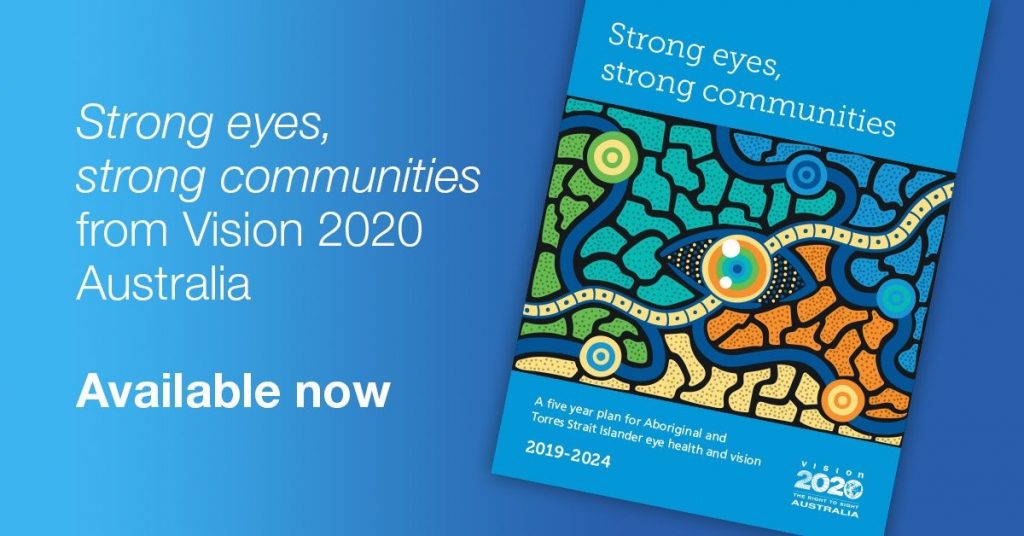

An end to the eye health and vision gap is within reach
Vision 2020 Australia, the peak body for the eye sector, is calling for action to ensure that Aboriginal and Torres Strait Islander People have the same access to eye care as other Australians.
The newly released Strong eyes, strong communities – A five year plan for Aboriginal and Torres Strait Islander eye health and vision, 2019-2024 sets out a plan to achieve this goal.
Most vision loss can be avoided or prevented through early identification and treatment, but Aboriginal and Torres Strait Islander people experience three times the rate of blindness and vision loss than non-Indigenous Australians and often wait much longer for treatment.
For example, Aboriginal and Torres Strait Islander people are currently waiting 63% longer on average for cataract surgery than non-Indigenous Australians.
Strong Eyes, strong communities describes what needs to be done to close this gap for vision and ensure eye problems in Aboriginal and Torres Strait Islander people are prevented wherever possible and treated early if they do develop.
Vision 2020 Australia has made 24 recommendations to implement the plan, which will require new funding of $85.5 million over the coming five years.
This funding will deliver more eye care services and glasses for Aboriginal and Torres Strait Islander people, support them to access the care they need and support the elimination of trachoma by 2020.
Vision 2020 Australia is also recommending other actions to improve overall planning and local pathways, strengthen the role of local community controlled services and increase access to specialist treatment.

The complete plan and Vision 2020’s recommendations for its implementation are
available to download.
Quotes attributable to Vision 2020 Australia CEO Judith Abbott:
“Too many Aboriginal and Torres Strait Islander people still experience avoidable vision loss and blindness, and those who have lost vision often find it difficult to access the support and services they need.”
“Now is the time for all governments and all sides of politics to join together with Aboriginal and Torres Strait Islander communities, their organisations and Vision 2020 Australia members to close the gap for vision.”
“That commitment, coupled with additional funding of $85.5 million over 5 years, will change the lives of many Aboriginal and Torres Strait Islander people, their families and their communities.”
“We look forward to working together to achieve a world class system that delivers culturally safe eye care to all Aboriginal and Torres Strait Islander people.”
Quotes attributable to National Aboriginal Community Controlled Health Organisation (NACCHO) Deputy CEO Dawn Casey:
“The Vision 2020 Australia Aboriginal and Torres Strait Islander Committee have been advocating for change in Aboriginal and Torres Strait Islander eye health and vision care and should be proud of their work in the formation of the Strong Eyes, Strong Communities report.”
“As recommended in the report, embedding eye health and vision care into Aboriginal Community Controlled Organisations will help ensure the eye needs of Aboriginal and Torres Strait Islander peoples are met and the gap in vision loss and blindness is closed.”
Quotes attributable to The Fred Hollows Foundation Indigenous Australia Program Manager Shaun Tatipata:
“Australia’s major political parties agree we need to Close the Gap in health outcomes between Aboriginal and Torres Strait Islander people and other Australians, and this commitment must be matched by increased funding.”
“Aboriginal and Torres Strait Islander people wait on average 63% longer for cataract surgery than non-Indigenous Australians. That’s not acceptable.”
“The Fred Hollows Foundation joins the call for new funding for the five year plan. It’s what Fred would have fought for.”
Key stats on Aboriginal and Torres Strait Islander People’s eye health
- Cataract is the leading cause of blindness for Aboriginal and Torres Strait Islander adults and is 12 times more common than for non-Indigenous Australians.
- Aboriginal and Torres Strait Islander people wait on average 63% longer for cataract surgery than non-Indigenous Australians.
- Almost two-thirds of vision impairment among Aboriginal and Torres Strait Islander people is due to uncorrected refractive error – often treatable with a pair of glasses.
- One in 10 Aboriginal and Torres Strait Islander adults is at risk of Diabetic Retinopathy, which can lead to irreversible vision loss.
- Australia is the only developed country to still have Trachoma, found predominately in Aboriginal and Torres Strait Islander communities.
ENDS
Media contact
Ben Jessup 0410 632 123 or bjessup@vision2020australia.org.au

